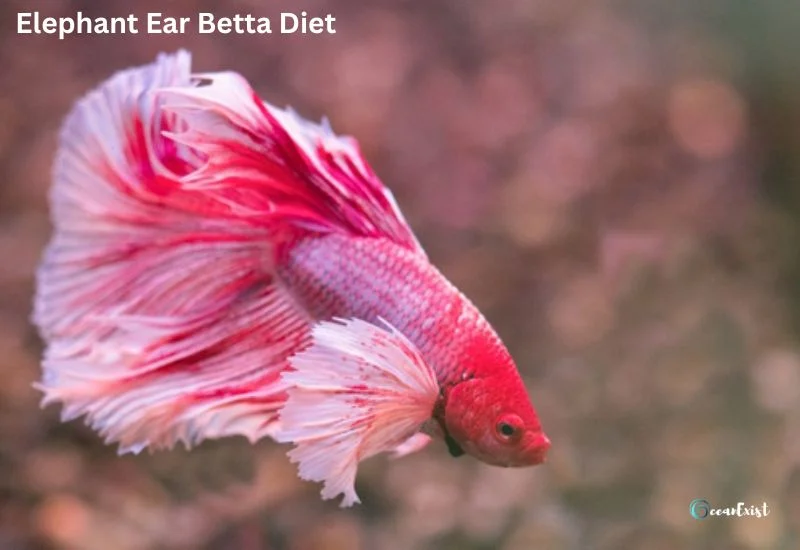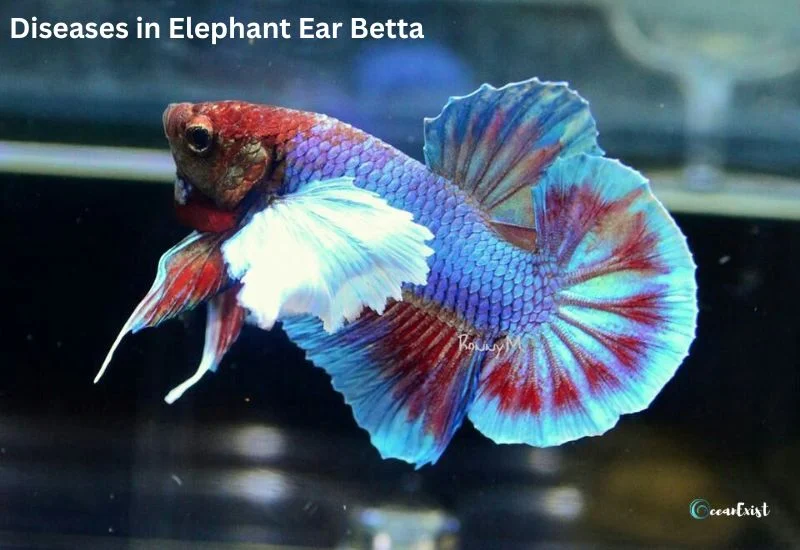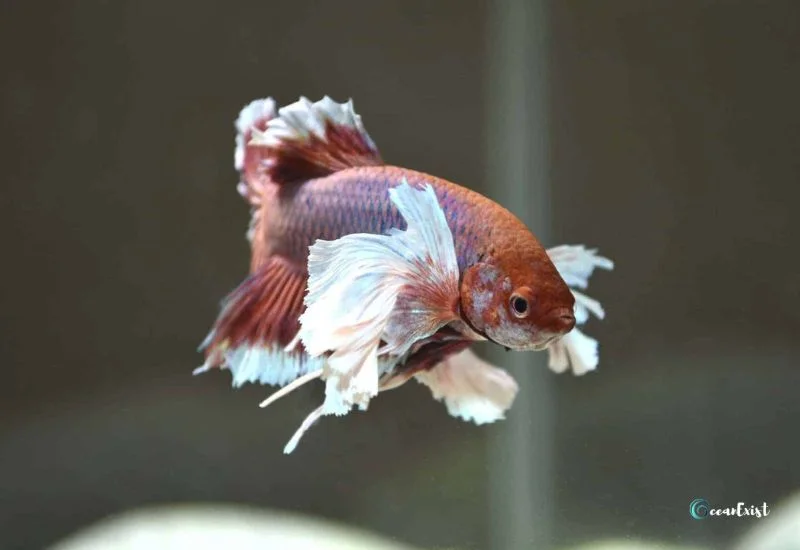Do you know the Elephant Ear Betta is the most beautiful yet aggressive type of Betta family? It is a territorial fish, which is why It has an aggressive nature. Male Elephant Ear Bettas are not recommended to house with female ones to avoid any fights in the aquarium.
The Elephant Ear Betta is also known as Dumbo Bettas. They are considered a popular aquarium type belonging to the tropical fish family. They have huge fins and tails that resemble elephants.
One interesting thing about the Betta family is that each Betta type has special care and a special diet regardless of being a member of the same family.
Elephant Betta Fish Overview
| Scientific Name | Betta splenden |
| Nature | Aggressive / fighting behavior |
| Size of EE (Elephant Ear) Betta | 2.5-3.5 inches |
| Appearance | Jewel bright colored having large tail and fins |
| Minimum Tank Size | 5-10 Gallons |
| Diet Type | Carnivore |
| Origin | Thailand, Cambodia, and Vietnam |
| Environment | Freshwater or River |
| Water pH Parameter | 8 |
| Water Temperature | 75-80 °F |
| Breed Type | Bubble Nest Eggs Layer / Floating nests |
| Care Level | Easy to care for / Beginner friendly |
Appearance Of Elephant Ear Betta
The dumbo fish has a very slim body and large pectoral floating fins. These fins can grow twice the size of their body. The male EE Bettas have larger and more brightly colored fins than female ones. Male Betta’s fins can grow up to 8 cm compared to the 6cm size of the pectoral fins of female ones.
Colors and Size
The Betta’s shades may range from blues and greens to purples. But have you ever seen the Elephant Ear Betta Dalmatian variant? Yes! It does exist, and imagine the beauty of your aquarium with EE Betta having black dots on their body.
Dumbo fish are very easy to care for, which is why they are considered beginner-friendly aquarium types of fish.
Male Elephant Ear Bettas do not enjoy sharing their tank with other Bettas as they are considered territorial and predatory fish. On the other hand, female Bettas have a very peaceful and friendly nature.
Average Lifespan
Elephant Ear Bettas have an average life span of 3-4 years. But if you provide them with a healthy environment and nutritious diet, their life span can increase up to 5 years. Poor water quality and improper environmental conditions may cut short their average lifespan.
SUMMARY
Elephant Ear Betta fish are blue, green, or purplish with dots on the body. They are slim and have large fins. Their average life span is three to four years.
Care Tips For Elephant Ear Betta
Dumbo Betta Tankmates
Just like other types of the Betta family, Elephant Ear Betta also possesses an aggressive nature. They are not recommended to house with other Bettas. You will not believe that Elephant Ear Bettas can turn into horrifying warriors even when they reflect their glimpse on the walls of the aquarium.
Always avoid housing two male Bettas in the same aquarium. The size of the aquarium should be big enough to provide elephant ears Betta a natural habitat easily.
Popular EE Bettas Tank Mates
- Snails
- Plecos
- Corydoras
- Shrimp
We have experienced snails making best mates with Bettas. But you should always observe the nature and behavior of your newly introduced mates. Despite the calm nature of snails, EE Bettas tend to pinch snail antennas.
If you observe any abnormal behavior in the aquarium, immediately separate Bettas to keep snails safe in the aquarium.
Dumbo Betta Diet

All types of Betta splenden family eat special types of carnivorous food. These splenden Bettas are found in the freshwater streams and rivers of Thailand, where their food consists mostly of small insects and crustaceans.
Flakes and fish pallets are amongst the best diet choices for EE Bettas. Always be careful not to eat their food, causing overheating and worsening their aggressive nature.
Always source food like bloodworms, brine shrimps, and mosquito larvae from authentic suppliers. Because food bought from local suppliers may cause infiltration in the aquarium.
To provide them with enough protein and nutrients, you should feed them live frozen foods twice a week.
Feeding Schedule For EE Betta Fish
You can make a feeding plan for feeding your Betta fish. Giving them food in batches and 4-6 times food a day is the best choice for their healthy lifestyle.
If you are feeding them frozen food, make sure to defrost it to make it easy for your Betta fish to digest it.
One more tip: Keep a fasting day for your Betta fish in your feeding plan. This will help you avoid any overfeeding.
Decor
- For a healthier Betta breed, it is advised to maintain the aquarium with colorful decor all around properly. Place soft pebbles in the lowermost layer of the aquarium.
- Then, make a sheet of fine sand gravel to enhance the beauty of the stones.
- Keep live plant-based decor in the aquarium. Place tropical lilies to illuminate the aquarium.
- Provide enough space for Betta to have privacy in the aquarium.
Avoid placing any rock or decor item with sharp edges in the aquarium to avoid any injury to Elephant Ear Bettas. Elephant Ear Bettas are an introverted type of species that like decor items in the aquarium.
Lighting
Elephant Ear Bettas love lighting in the aquarium. You should consider adding enough lights to illuminate their tank. However, always keep in mind the temperature of the aquarium because excess lighting may overheat the aquarium.
Tank Size
It would help if you built a deep tank with great height to provide them enough room. Elephant Ear Bettas have labyrinth organs, which means that they breathe from the water’s surface. So, they live in shallow waters.
Arrange a tank with ample space for their feeding and filtration. An ideal size tank for housing Elephant Bettas is 3 square feet.
Water Parameters
Make sure that your water quality is good and has standard parameters like temperature, pressure, and oxygenated system.
The rule of thumb is to provide water conditions that are close to their natural habitat to avoid any health issues.
Dumbo Fish tank must have the following water parameters:
- pH level between 6.5-8.0
- Temperature ranging from 75-82 °F
- Water hardness level ranges from 3-4 GH.
Filtration System
A filtration system should be properly installed in the aquarium. The filtration system is necessary for their breathing and healthy living. Installation of the filtration system requires a large aquarium.
You can install an air-powered filtration system or any other internal filtration that does not move fast because there will be chances of change in the water environment.
A standard filtration system helps EE Betta live a healthier life and prevent diseases.
Common Diseases and Preventive Cure

Diseases
Elephant Ear Bettas may catch disease just like any other fish. These diseases are due to improper water conditions, a worse aquarium environment, and other parameters.
Here are common diseases in EE Bettas:
Ich
This is due to unbalanced water parameters in the aquarium.
Fins Decay
When you overfeed them, their digestion does not perform well frequently, which causes their fins to rot. Their body color gets dried and white.
Cure and Preventive Measures
Always keep checking their health and water environment. Improper water conditions cause a lot of diseases, and Elephant Ear Bettas show an aggressive nature.
- Do not change water conditions suddenly.
- Follow the standard checklist of water parameters.
- Provide enough tank room to match their natural habitat.
- Improve the water filtration system.
- Regular water changes in the aquarium
SUMMARY
Bacterial and fungal diseases are common in Elephant Ear Bettas. These are due to the bad water conditions and harsh environment. Use medication in the water. Change half of the tank’s water after a week. The tissues on the fins look alive if they are in their usual environment.
Conclusion
In conclusion, Elephant Bettas are one of the most beautiful members of the beta family. They are considered amongst the top choices of aquarium enthusiasts with colorful bodies and large pectoral fins.
They possess an aggressive nature due to territorial behavior. Do not think of housing two or more male Bettas in the same aquarium.
With a good filtration system and standard water parameters, EE Bettas are easy to care for and house in a captive environment.
Next Read: Halfmoon Betta Fish
